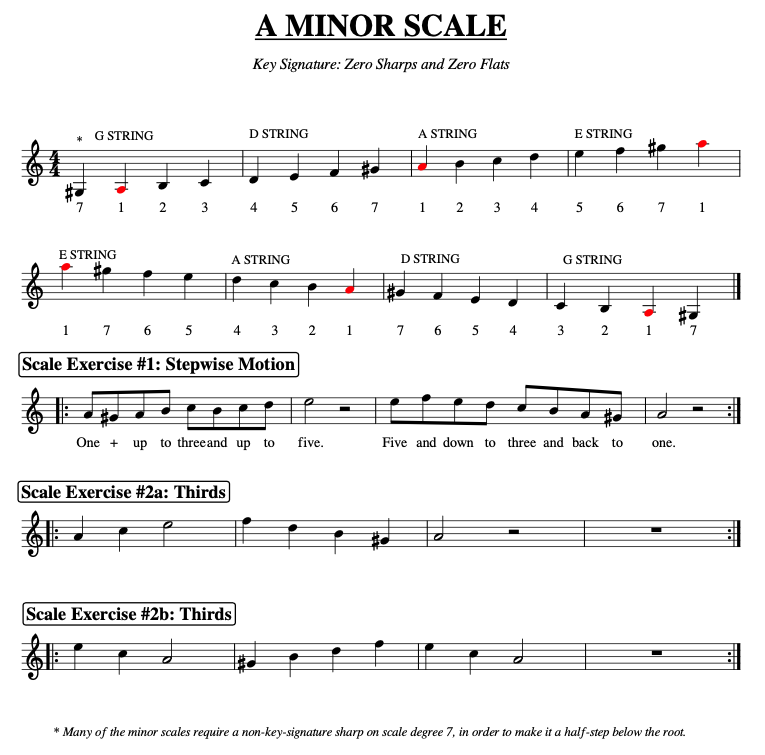In previous lessons, we’ve learned about the names of musical notes and the intervals between them. In this lesson, we begin to apply what we’ve learned in order to understand scales. This will be the first of very, very few lessons which will ask you to memorize a definition, the definition of the major scale.
What Is A Scale?
In music theory, a scale is a series of musical notes that follow some pattern. When we learned all the twelve notes of Western music, we were learning a scale; the twelve notes make a series that is called the chromatic scale. The chromatic scale contains “all the colors”, that is, all the tones of Western music, so it is called “chromatic” (Gk. chroma = color). All twelve notes are necessary for our system of music, but the chromatic scale is not so useful as a starting point for understanding music. All the notes would be too many notes on which to logically make a piece of music, so we whittle down to less notes to form useful musical scales. Besides the twelve-note chromatic scale, there are numerous seven-note musical scales which are the foundations on which our music is built. These are called diatonic scales. The most common two of these are the major scale and the minor scale. There are also five-note, abbreviated scales that are based on the seven-note scales and those are called pentatonic scales. They drop a couple notes from the seven-note (diatonic) scales that they are based on. Again, the most common pentatonic scales are the major pentatonic scale and the minor pentatonic scale. This information is included here to give a brief description of “what is a musical scale?” – you do not need to memorize this information, just read it carefully and try to understand as much of it as possible. In this lesson, we will be concerned only with learning the major scale.
The Major Scale
The major scale consists of eight ascending notes, with a half step between the third and the fourth, and a half step between the seventh and the eighth, and all other notes are a whole step apart. The eighth note of a major scale is the same as the first note, but an octave higher. Eight “ascending notes” means eight notes going up in tonality, from lower to higher notes.
It has been mentioned in previous lessons that intervals are everything in music theory. The placement of half steps and whole steps in a musical scale is what gives the scale it’s character.
Let’s look at the C Major scale on a piano keyboard:

As you can see by studying the illustration above, there are numbers beneath the keys that represent the scale. These are the note numbers of the scale, also called the degrees of the scale, and there are eight of them. The first note, or first degree of a scale is called the root note, or the tonic. The eighth note, or eighth degree of the scale is called the octave, meaning “eighth degree”. The scale always ends with an octave note – the same note as the first, but an octave higher in pitch. The C major scale, shown above, is the only major scale that has only natural notes (no sharps or flats in this major scale).
A major scale has a half step between the third and fourth degrees. Notes 3 and 4 above are the notes E and F, which are a half step apart. A major scale has a half step between the seventh and eighth degrees. Notes 7 and 8 above are the notes B and C, which are a half step apart. In a major scale, all other notes are a whole step apart. Study the image above and you will see that all the other notes skip a black key between each note; when you skip one key on a piano between any two notes, those notes are a whole step apart.
Now let’s look at a C major scale on the guitar fretboard:

The numbers along the bottom of the diagram above still represent the fret numbers. The new red numbers along the top represent the degrees of the scale: 1st note, 2nd note, 3rd note, etc. The major scale always consists of eight ascending notes, with a half step between the 3rd and the 4th, and between the 7th and the 8th, and all other notes are a whole step apart. You can see this major scale pattern clearly by studying the diagram, where notes 3 & 4 (E & F) and notes 7 & 8 (B & C) are only one fret apart. All other notes are two frets apart.
A single fret on a guitar or mandolin represents a half step. Skipping a fret between two notes means that those notes are a whole step apart.
Here is the C major scale on a mandolin fretboard:

Note the intervals of the major scale, from note one, a whole step, whole step, half step, whole step, whole step, whole step, half step. To put it another way, from the first note of the scale you move up two frets, then two frets, then one fret, then two frets, two frets, two frets, and finally one fret. A major scale consists of eight ascending notes, with a half step between notes 3 & 4 and notes 7 & 8, and all other notes are a whole step apart.
The same pattern applies no matter what the starting note is (the root, or tonic note, of a scale is the starting note). To understand and illustrate this, study the major scale intervals below. The images illustrate the D Major scale on mandolin, the F Major scale on guitar, and the G Major scale on piano. All major scales follow the same pattern, because the intervals between the notes is what makes the scale major. Sharp and flat notes must be used to maintain the correct intervals for every major scale except the scale of C.



Study each of the three diagrams above closely, paying attention to the intervals between each note of the scales.
Using Easy Scale Patterns On Fretted Instruments
The following video by Brad Laird illustrates very well how the major scale intervals form a pattern on a stringed instrument like mandolin and guitar. Once the pattern is learned, you can easily find the major scale starting on any note without knowing the names of all the notes. This is because a major scale always has the same intervals, regardless of the starting note (root, or tonic note). The major scale always consists of eight ascending notes, with a half step between the 3rd & 4th, and the 7th & 8th, and all other notes are a whole step apart.
Brad’s video is originally published at his website on the following page,
which also includes the tablature he refers to: http://www.bradleylaird.com/playthemandolin/videos-what-is-a-maj-scale.html
Writing Out A Major Scale
Writing out major scales can be a tedious chore, but in my opinion, it is a good way to get a handle on, and test your understanding of, this aspect of music theory. In the lessons ahead and for the rest of your musical life, learning to write out major musical scales can also give you shortcuts to finding minor scales, chords and arpeggios as well. To write out a musical scale all you need to know is the definition of a major scale so that you get the intervals correct, and remember this fact about the natural notes: that E and F as well as B and C are special; they are only a half step apart, while all other notes are a whole step apart. The other notes haves sharp (or flat) notes between them that you can use to maintain the intervals of a major scale.
In this lesson, I have repeated several times in various words the definition of a major scale. I want you to remember it. Here it is again:
Once memorized, and combined with what we’ve learned in previous lessons, you will be able at any time to sit down with pencil and paper and puzzle out any major scale! Just be sure to use all seven “note name” letters of the alphabet and flatten or sharpen notes as necessary to maintain the intervals of the major scale definition. I’ll write out the scales for A Major, Bb Major and E Major below to illustrate.
A – B – C# – D – E – F# – G# – A
Bb – C – D – Eb – F – G – A – Bb
E – F# – G# – A – B – C# – D# – E
Homework
1. Re-read this lesson and play the scales mentioned on your musical instrument.
2. Memorize the definition of the major scale.
3. Refer to the three scales I wrote out at the end. In your mind, calculate the interval between each note of those scales, begininning with the first note and working up the scale.
4. Practice writing out a major scale using your mind and scratch paper.
5. If you play a fretted instrument, memorize the “phone number” trick from Brad Laird’s video.
Re-cap
In this lesson, we learn . . .
1. What is a musical scale.
2. What makes a major scale.
3. How to find major scales on various instruments.
If you find it difficult to understand any of the concepts in this lesson, take time to re-read the lesson with your instrument of choice at hand, and play the notes discussed in this lesson. Listen to the sounds, and think about how they relate to what is being taught here. You can make suggestions or ask questions by shooting me an email, I’ll do my best to answer.
























